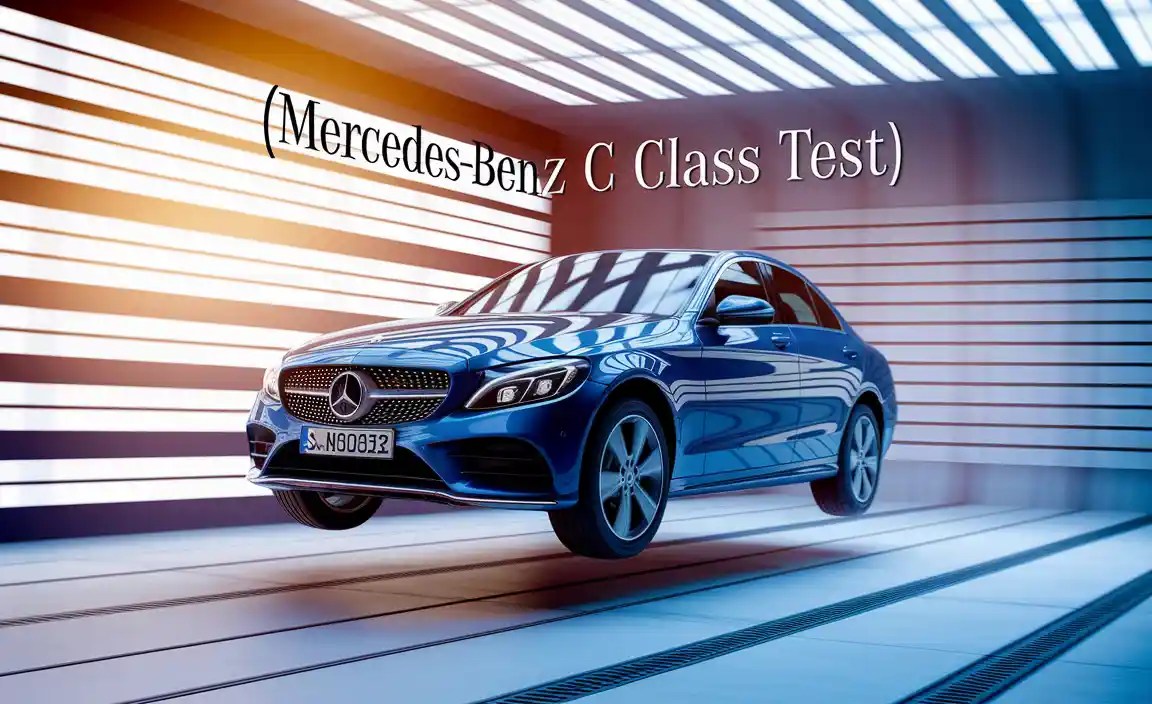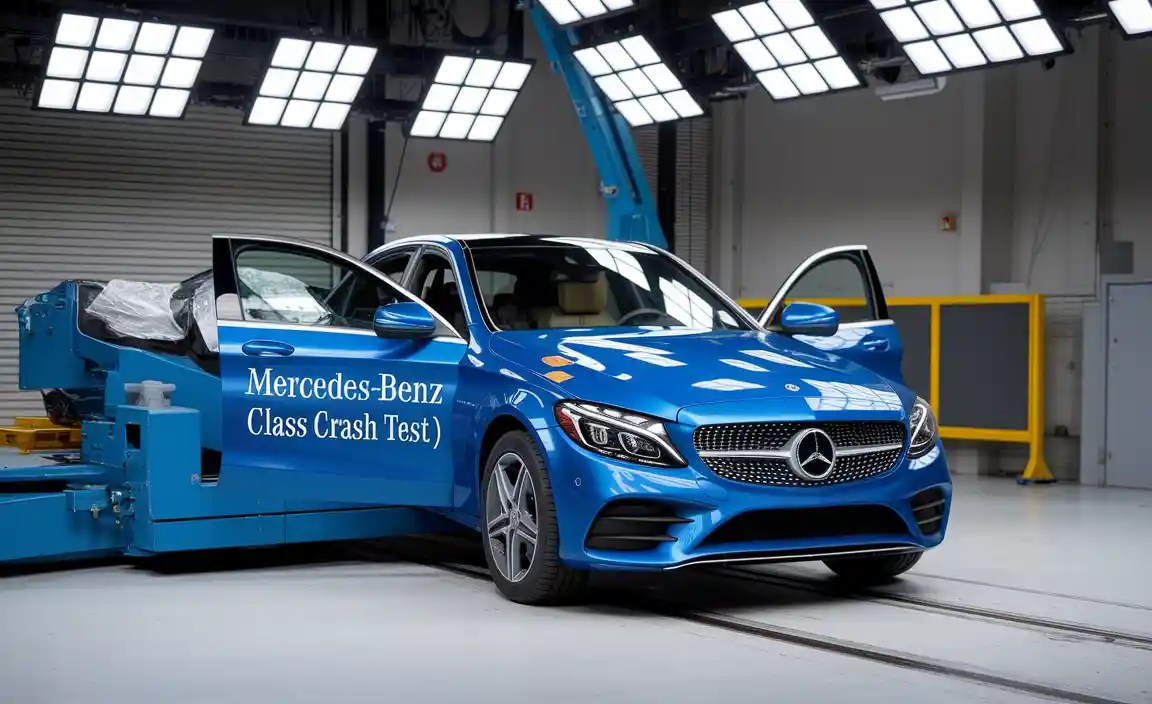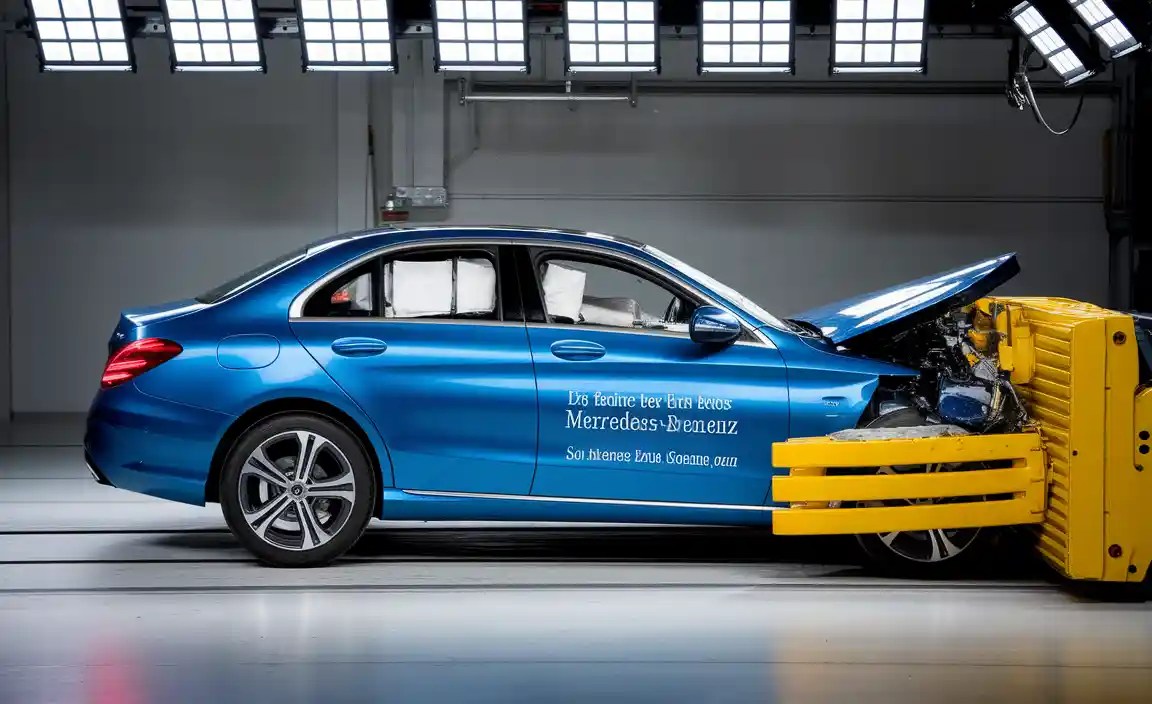Mercedes-Benz C Class Crash Test: Ultimate Safety, Perfect Drive
The Mercedes-Benz C-Class consistently performs exceptionally in crash tests, demonstrating why it’s a leader in passive and active safety. Its robust engineering, advanced driver-assistance systems, and meticulous design ensure top-tier protection for occupants, blending luxury with unparalleled peace of mind on every drive.
When you’re behind the wheel of a Mercedes-Benz, you expect a certain level of excellence. That includes knowing your vehicle is engineered for the utmost safety. Many drivers, both seasoned Mercedes-Benz owners and those considering a purchase, often wonder: “How does the C-Class hold up in a crash?” It’s a crucial question because a car’s safety rating and tested performance directly impact peace of mind.
This guide will dive deep into the C-Class crash test results, breaking down what those ratings mean and highlighting the advanced safety features that contribute to its stellar reputation. We’ll explore the rigorous testing procedures and understand how Mercedes-Benz prioritizes your well-being.

Understanding C-Class Crash Test Ratings: A Beginner’s Guide
When we talk about crash tests, we’re referring to standardized evaluations conducted by independent organizations to assess how well vehicles protect their occupants in various collision scenarios. For the Mercedes-Benz C-Class, these tests are not just benchmarks; they are a testament to decades of automotive safety innovation.

Who Conducts Crash Tests?
Several organizations worldwide perform these critical safety assessments. The most prominent include:
The National Highway Traffic Safety Administration (NHTSA) in the United States: NHTSA provides a 5-Star Safety Ratings program, which is easily understandable for consumers. A higher star rating indicates better protection.
The Insurance Institute for Highway Safety (IIHS) in the United States: IIHS uses a different rating system, including “Good,” “Acceptable,” “Marginal,” and “Poor.” They also award “Top Safety Pick” and “Top Safety Pick+” designations for vehicles that excel in their testing.
Euro NCAP (European New Car Assessment Programme): This is the European equivalent, providing star ratings from one to five, assessing adult occupant protection, child occupant protection, pedestrian protection, and safety assist systems.
What Do the Ratings Mean?
A high crash test rating, particularly a 5-star rating from NHTSA or a “Top Safety Pick+” from IIHS, signifies that a vehicle has successfully met stringent safety standards across multiple impact types. This means the car’s structural integrity, airbag systems, and seatbelt technology work together effectively to minimize injury in the event of an accident. For the C-Class, these high marks are a consistent theme, reflecting its advanced engineering.
The Mercedes-Benz C-Class: A Legacy of Safety
The C-Class has a long-standing reputation for safety, often setting benchmarks for its segment. Let’s look at why this mid-size luxury sedan consistently earns top marks and what makes its safety features so effective.
Structural Integrity: The Foundation of Safety
At the core of any vehicle’s safety performance is its body structure. Mercedes-Benz employs advanced high-strength steel alloys and precise engineering to create a rigid passenger cell.
High-Strength Steel: This material is key to absorbing and dissipating impact energy, preventing it from reaching the occupants.
Energy-Absorbing Zones: The front and rear of the C-Class are designed with crumple zones. These areas are engineered to deform in a controlled manner during a collision, absorbing a significant portion of the impact force.
Reinforced Cabin: The passenger compartment, or “safety cell,” is designed to maintain its shape even under extreme pressure, offering a protective bubble for occupants.
Airbag Systems: Layered Protection
The C-Class is equipped with an extensive network of airbags designed to deploy in specific scenarios and at appropriate pressures.
Front Airbags: These deploy from the steering wheel and dashboard to protect the driver and front passenger during frontal impacts.
Side Airbags: Mounted in the seats or doors, these protect the torso and pelvis during side-impact collisions.
Curtain Airbags: These run along the roofline to shield the heads of occupants in the front and rear during side impacts and rollovers.
Knee Airbags: Often included for the driver, these protect the legs from impacting the dashboard.
Restraint Systems: Keeping You Secure
Complementing the airbags are advanced seatbelt systems.
Pre-Safe® System: This innovative Mercedes-Benz technology can detect an impending collision and proactively prepare the vehicle’s safety systems. It can tighten seatbelts, adjust seats, and close windows and the sunroof to optimize occupant protection just before an impact. Learn more about the incredible advancements in automotive safety at NHTSA’s safety features page.
Belt Tensioners and Force Limiters: These devices ensure the seatbelt holds occupants firmly without causing excessive strain during a crash.
Detailed Crash Test Scenarios and C-Class Performance
Crash tests are designed to simulate real-world accident conditions. Here’s how the C-Class typically performs across the most critical tests conducted by organizations like IIHS and NHTSA.

Frontal Collision Tests
In a frontal collision, the focus is on how well the vehicle protects occupants when the front of the car impacts a barrier or another vehicle.
Small Overlap Front Test (IIHS): This is a particularly challenging test where only about a quarter of the vehicle’s front end on the driver’s side hits a rigid barrier at 40 mph. It’s designed to mimic specific types of crashes where the vehicle’s safety structure might be compromised. The C-Class has consistently performed very well in this test, with its robust structure and advanced airbag systems maintaining the integrity of the occupant space.
Moderate Overlap Front Test (IIHS/NHTSA): This simulates a head-on collision covering 40% of the vehicle’s front width. The C-Class’s engineering ensures that the forces are managed effectively, minimizing intrusion into the driver and passenger area.
Side Impact Tests
Side impacts are often more dangerous due to the relative lack of protective structure on the sides of vehicles.
Side Crash Test (NHTSA/IIHS): This test simulates a collision where the front of one vehicle hits the side of another at an angle. The C-Class’s combination of strong side structures, side airbags, and curtain airbags is crucial for preventing serious injuries in these scenarios. The vehicle typically receives top marks for its ability to shield occupants from the intruding force.
Roof Strength and Rollover Resistance
While rollovers are less common, they can be severe.
Roof Strength Test (IIHS): This test assesses how well the vehicle’s roof can withstand crushing forces, indicating its safety in rollover accidents. A stronger roof structure is vital for preventing the roof from collapsing onto the occupants. The C-Class’s design incorporates strong pillars and roof rails to provide excellent resistance.
Rear Collision Safety (Whiplash Prevention)
Rear-end collisions can cause whiplash injuries.
Rear Crash Protection / Head Restraint Evaluation (IIHS): This evaluates the effectiveness of the seats and head restraints in reducing the risk of whiplash in a rear-end impact. The C-Class typically features well-designed head restraints and supportive seats that help mitigate whiplash.
The Table of Safety: C-Class Crash Test Highlights (Example for a recent model year)
To illustrate the C-Class’s consistent performance, let’s look at a hypothetical breakdown of typical results based on recent models. Please note that exact ratings can vary slightly by model year and specific testing body.

| Test Type | NHTSA Rating (5-Star Scale) | IIHS Rating (Good/Acceptable/Marginal/Poor) | Key C-Class Safety Features Contributing |
| :————————— | :————————– | :—————————————— | :————————————— |
| Frontal Driver | ★★★★★ | Good | High-strength steel, adaptive airbags, pre-tensioned seatbelts |
| Frontal Passenger | ★★★★★ | Good | Robust structure, advanced airbag system |
| Side Driver | ★★★★★ | Good | Side airbags, curtain airbags, reinforced B-pillar |
| Side Passenger | ★★★★★ | Good | Side airbags, curtain airbags, reinforced structure |
| Side Pole Driver | ★★★★★ | Good | Curtain airbags, side thorax airbags |
| Small Overlap Front (Driver) | N/A | Good | Advanced front structure, airbag control |
| Roof Strength | N/A | Good | Reinforced A & B pillars, high-strength steel roof frame |
| Head Restraint (Rear) | N/A | Good | Supportive seat design, effective headrests |
| Overall Safety Rating | ★★★★★ | Top Safety Pick+ (Typical) | Comprehensive suite of active and passive safety systems |
Active vs. Passive Safety: The C-Class Advantage
It’s important to distinguish between passive and active safety features.
Passive Safety: These are features that protect occupants during a crash, such as airbags, seatbelts, and the vehicle’s structural integrity. The C-Class excels here due to its robust construction and well-integrated passive systems.
Active Safety: These are systems designed to prevent a crash from happening in the first place. The C-Class is equipped with an impressive array of active safety technologies, often referred to as Mercedes-Benz Driver Assistance Systems. These systems use sensors, cameras, and radar to monitor the road and intervene when necessary.
Mercedes-Benz Driver Assistance Systems: Preventing Accidents
The C-Class isn’t just built to protect you in a collision; it’s designed to help you avoid one altogether. Many advanced driver assistance systems (ADAS) are standard or available on the C-Class, contributing to its strong overall safety performance and driver confidence.

Key Active Safety Features:
Active Brake Assist: This system can warn the driver of a potential collision with vehicles, pedestrians, or cyclists and can automatically apply the brakes if the driver doesn’t react sufficiently. It’s a critical system for preventing or mitigating frontal crashes. You can find more information on how these technologies work on the IIHS’s page on driver assistance.
Blind Spot Assist: Uses radar to detect vehicles in the driver’s blind spots and warns them with a visual cue and an audible alarm.
Lane Keep Assist: Can detect unintentional lane departure and steer the vehicle back into its lane or warn the driver.
Adaptive Cruise Control (DISTRONIC): Maintains a set speed and distance from the vehicle ahead, automatically adjusting speed as needed. Some advanced versions can even assist with steering.
Evasive Steering Assist: If a pedestrian is detected and the driver performs an evasive steering maneuver, this system can assist by adding programmed steering torque.
Cross-Traffic Alert: Can detect approaching traffic when backing out of a parking space and warn the driver, even automatically braking.
These active safety features work together to create a vigilant co-pilot, reducing driver fatigue and increasing reaction times, which is paramount in preventing accidents.
What About Different C-Class Generations and Trims?
It’s worth noting that while Mercedes-Benz maintains a strong safety commitment across all generations of the C-Class, specific safety features and their performance can evolve with each new model year and generation. Newer models often incorporate the latest advancements in both passive and active safety technology.
Model Year Considerations
When researching a specific C-Class model, always check the safety ratings and features for that particular model year. Manufacturers frequently update their vehicles, and a model from 2023 might have more advanced safety systems than one from 2019, even if both received excellent ratings for their time.
Trim Levels and Options
While the core safety structure of the C-Class is consistent across trims, certain advanced driver assistance systems might be standard on higher trims or available as optional packages. For instance, the full suite of semi-autonomous driving features might be part of an optional assistance package. Always verify the specific safety equipment included with the C-Class you are interested in.
Maintaining Your C-Class for Optimal Safety
Even the safest vehicle requires proper maintenance to ensure its safety systems function correctly.
Tire Pressure: Properly inflated tires are crucial for handling and braking, directly impacting active safety system effectiveness.
Brake System: Regular inspection and maintenance of brake pads, rotors, and fluid are essential for optimal stopping power.
Sensor Cleaning: The sensors and cameras used by active safety systems can become obscured by dirt, snow, or debris. Keeping them clean ensures they can operate accurately. Consult your owner’s manual for specific cleaning instructions.
* Professional Inspections: Schedule regular check-ups with a certified Mercedes-Benz technician to ensure all safety systems are calibrated and functioning as intended.
Conclusion: Drive with Confidence in Your C-Class
The Mercedes-Benz C-Class isn’t just a symbol of luxury and performance; it’s a fortress on wheels. The rigorous crash test results from reputable organizations like NHTSA and IIHS consistently place the C-Class at the pinnacle of automotive safety. This is achieved through a combination of a meticulously engineered, high-strength body structure, an advanced network of airbags and restraint systems, and a suite of cutting-edge driver assistance technologies designed to prevent accidents before they happen.
From its robust crumple zones and reinforced safety cell to intelligent systems like Active Brake Assist and Pre-Safe®, every element is designed with one primary goal: your protection. When you choose a C-Class, you’re not just choosing a car; you’re choosing a commitment to safety that allows you to enjoy the drive with unparalleled peace of mind. Regular maintenance and awareness of your vehicle’s specific safety features will ensure you continue to experience the ultimate in a perfect drive, mile after mile.
Frequently Asked Questions About C-Class Crash Tests:
Q1: How safe is the latest Mercedes-Benz C-Class?
A1: The latest Mercedes-Benz C-Class routinely achieves top safety ratings, typically earning 5 stars from NHTSA and “Top Safety Pick+” from IIHS. This reflects its advanced structural design, comprehensive airbag system, and state-of-the-art driver assistance technologies.
Q2: What does a 5-star safety rating mean for the C-Class?
A2: A 5-star rating from organizations like NHTSA signifies the highest level of protection in crash tests. It means the C-Class demonstrated excellent performance in frontal, side, and rollover crash simulations, offering superior occupant safety.
Q3: Are all Mercedes-Benz C-Class models equally safe?
A3: While Mercedes-Benz prioritizes safety across all models, safety features and ratings can evolve significantly between generations and model years. Newer C-Class vehicles typically have more advanced active and passive safety systems than older ones.
Q4: What are the most important active safety features in the C-Class?
A4: Key active safety features include Active Brake Assist, Blind Spot Assist, Lane Keep Assist, and Adaptive Cruise Control (DISTRONIC). These systems help prevent accidents by monitoring the surroundings and intervening when necessary.
Q5: How does the C-Class perform in the IIHS Small Overlap Frontal Test?
A5: The C-Class generally earns a “Good” rating in the IIHS Small Overlap Frontal Test, which is a rigorous simulation. This indicates its strong structure and advanced safety systems effectively protect occupants even in this challenging type of collision.
Q6: What is the Mercedes-Benz Pre-Safe® system?
A6: Pre-Safe® is an intelligent system that detects an imminent crash and prepares the vehicle’s safety measures beforehand. It can tighten seatbelts, adjust seats, and close windows and sunroof to better protect occupants during the impact.






